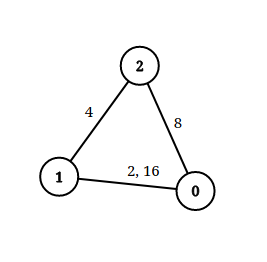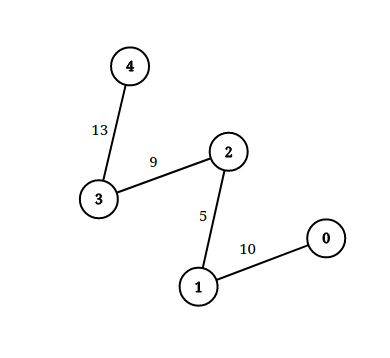1697. Checking Existence of Edge Length Limited Paths
Description
An undirected graph of n nodes is defined by edgeList, where edgeList[i] = [ui, vi, disi] denotes an edge between nodes ui and vi with distance disi. Note that there may be multiple edges between two nodes.
Given an array queries, where queries[j] = [pj, qj, limitj], your task is to determine for each queries[j] whether there is a path between pj and qjsuch that each edge on the path has a distance strictly less than limitj .
Return a boolean arrayanswer, where answer.length == queries.length and the jth value of answer is true if there is a path for queries[j] is true, and false otherwise.
Example 1:

Input: n = 3, edgeList = [[0,1,2],[1,2,4],[2,0,8],[1,0,16]], queries = [[0,1,2],[0,2,5]] Output: [false,true] Explanation: The above figure shows the given graph. Note that there are two overlapping edges between 0 and 1 with distances 2 and 16. For the first query, between 0 and 1 there is no path where each distance is less than 2, thus we return false for this query. For the second query, there is a path (0 -> 1 -> 2) of two edges with distances less than 5, thus we return true for this query.
Example 2:

Input: n = 5, edgeList = [[0,1,10],[1,2,5],[2,3,9],[3,4,13]], queries = [[0,4,14],[1,4,13]] Output: [true,false] Explanation: The above figure shows the given graph.
Constraints:
2 <= n <= 1051 <= edgeList.length, queries.length <= 105edgeList[i].length == 3queries[j].length == 30 <= ui, vi, pj, qj <= n - 1ui != vipj != qj1 <= disi, limitj <= 109- There may be multiple edges between two nodes.
Solutions
Solution: Two Pointers + Union Find
- Time complexity: O(mlogm+eloge)
eisedgeList.length
- Space complexity: O(m+n)
JavaScript
js
/**
* @param {number} n
* @param {number[][]} edgeList
* @param {number[][]} queries
* @return {boolean[]}
*/
const distanceLimitedPathsExist = function (n, edgeList, queries) {
const m = queries.length;
const indexedQueries = queries.map((query, index) => ({ query, index }));
const uf = new UnionFind(n);
const result = Array.from({ length: m }, () => false);
let edge = 0;
edgeList.sort((a, b) => a[2] - b[2]);
indexedQueries.sort((a, b) => a.query[2] - b.query[2]);
for (const { query, index } of indexedQueries) {
const [p, q, limit] = query;
while (edge < edgeList.length && edgeList[edge][2] < limit) {
const [u, v] = edgeList[edge];
uf.union(u, v);
edge += 1;
}
if (uf.find(p) === uf.find(q)) {
result[index] = true;
}
}
return result;
};
class UnionFind {
constructor(n) {
this.groups = Array.from({ length: n }, (_, index) => index);
this.ranks = Array.from({ length: n }, () => 0);
}
find(x) {
if (this.groups[x] === x) return x;
const group = this.find(this.groups[x]);
this.groups[x] = group;
return group;
}
union(x, y) {
const groupX = this.find(x);
const groupY = this.find(y);
if (groupX === groupY) return false;
if (this.ranks[groupX] > this.ranks[groupY]) {
this.groups[groupY] = groupX;
} else if (this.ranks[groupX] < this.ranks[groupY]) {
this.groups[groupX] = groupY;
} else {
this.groups[groupY] = groupX;
this.ranks[groupX] += 1;
}
return true;
}
}